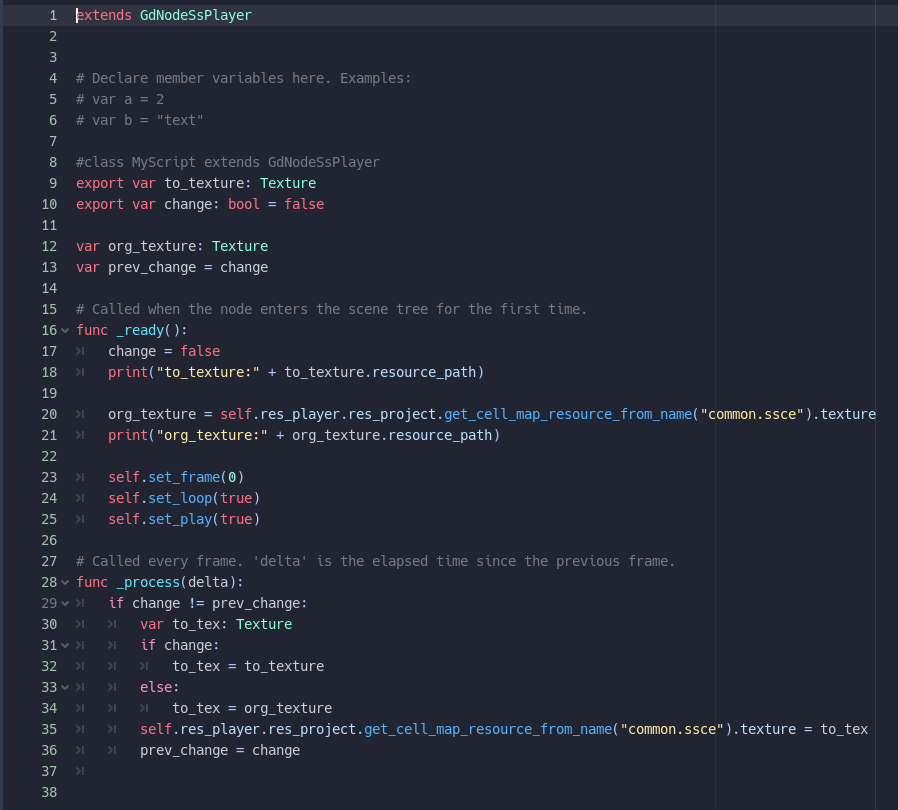SpriteStudio Player for Godot
Godot Engine has seen a surge in popularity recently, and we are thrilled to announce the availability of our SpriteStudio Player for this engine widely used by indie game developers.
Implementation
SpriteStudio is our versatile 2D animation tool, which offers character animation, effects, layouts, cutscenes, etc… If you are not familiar with it yet, check out our web page and get the free starter license that is available for individual users: https://www.webtech.co.jp/spritestudio/index.html
SpriteStudio Player – SSPLayer in short – is a program that allows the 2D animations created with SpriteStudio to be played on various game engines and platforms.
Godot is especially popular for the development of 2D games. For example, it supports pixel-based coordinate systems, comes with a tilemap editor in standard, and provides a 2D rendering engine that is independent of the 3D engine, making it possible to more easily and efficiently develop 2D games.
However, it does not have dedicated tools for the authoring of complex character animations, 2D effects, UI effects, etc., which is why it was a no-brainer to build a version of SSPlayer for Godot, so that developers can benefit from all these features!
SSPlayer for Godot features
Performance
The emphasis was put on the drawing performance during playback, so the SSPlayer for Godot was implemented as a C++ custom module rather than a GDScript-based one. The player relies on the latest version of the SpriteStudio SDK, and therefore supports its functions up to version 7.0.
Easy Playback
In order to play a SpriteStudio animation in your game, you simply have to save the project file (.sspj) in Godot’s resources folder, and then select it in the Inspector of the SpriteStudio Player node. There is no need to convert the data before using it (or even to import it for that matter), which makes for a very streamlined workflow.
(Note that this procedure may slightly change once we introduce support for binary data support as described below.)
Dynamic control via the GDScript API
In addition to the play/stop, frame-by-frame, and loop settings that can be set in the Inspector, you can also use the GScript API to receive Godot signals and obtain values when keyframes are reached, and use functions for dynamically switch textures.
Here is what a script looks like:

Below is CRI Middleware’s mascot Ringo-chan running on the Godot IDE.
Future plans
Providing pre-built binaries
Since SSPlayer for Godot is built as a C++ custom module, it is currently necessary to clone the repository and build the entire Godot Engine in order to test the operation of the player.
This may prove cumbersome, especially if you are not too familiar with this process. Therefore, we are hoping to provide pre-built binaries in the future (at least for Windows and Mac).
Support for unique binary data
We are working on proprietary binary data support to reduce the size of the data included in the game and to shorten the parsing time. The data will be in the ssfb2 format that is output by the SsConverterVer2 tool.
Resolving incompatibilities
Finally, some SpriteStudio features cannot currently be implemented in Godot due to compatibility issues with its rendering engine. Since Godot is updated at a rapid pace, features that are currently difficult to support may become implementable later. We plan to monitor the situation and make the features available when possible.
Download
SSPlayer for Godot is available for free on GitHub:
GitHub – SSPlayer for Godot public page
The current version is v1.1.1. It supports Godot versions 3.5 and 4.3.
Sample data is also included.
Do not hesitate to send us feedback so that we can make SSPlayer for Godot as useful as possible for all game developers!

